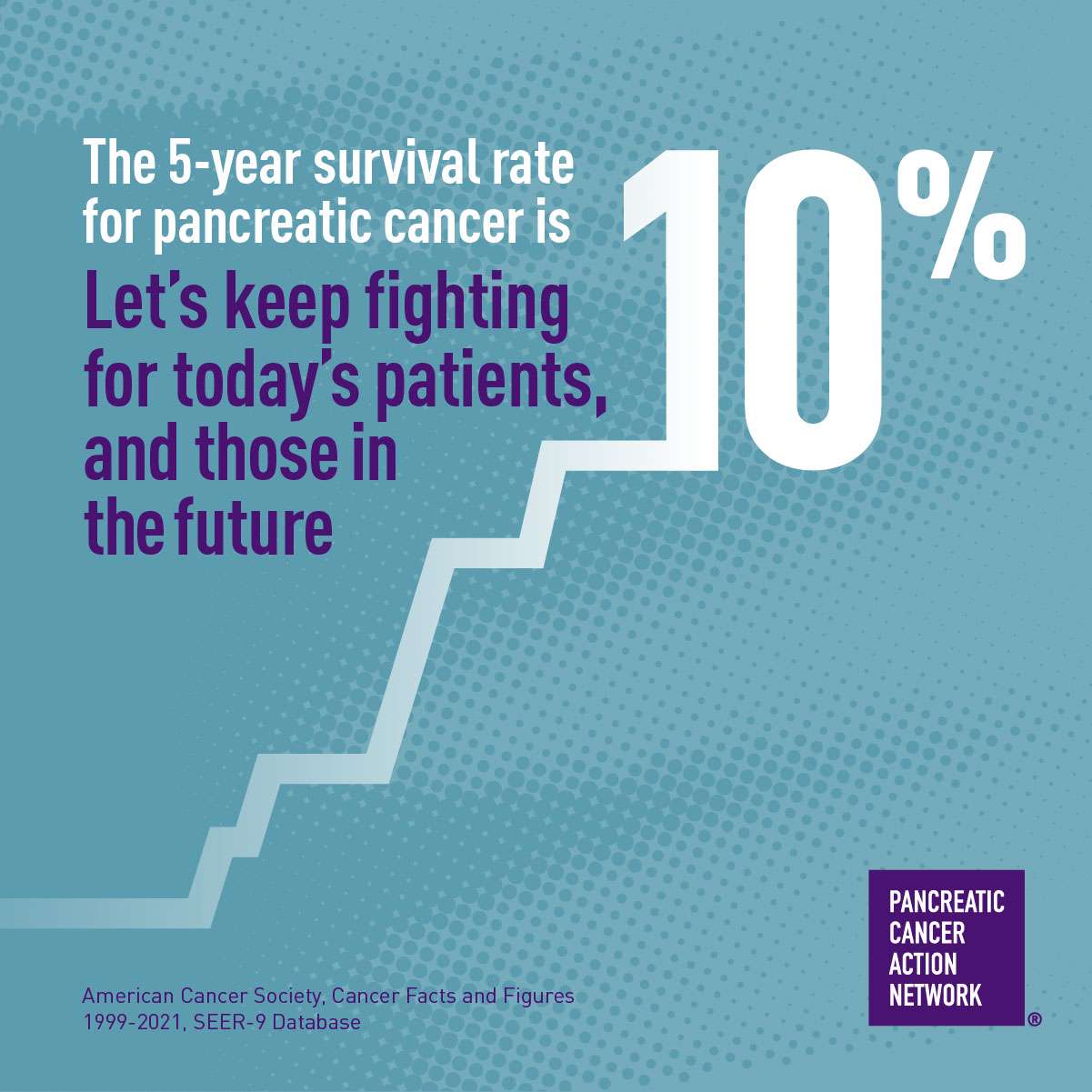What Is the 5 Year Survival Rate for Pancreatic Cancer
On This Page:

- What Is the Five-Year Survival Rate for Pancreatic Cancer?
- What Is the Pancreatic Cancer Survival Rate by Stage?
- What Is the Survival Rate After Surgery?
- What Can Patients Do to Improve Their Chances?
- Survivor Stories
- How Is the Survival Rate Determined?
- Why Is Early Detection Important?
Every pancreatic cancer patient's case is unique, and it's not possible to predict each person's outcome. But, population-wide studies are done to estimate the likelihood that a person diagnosed with different types of cancer, like pancreatic cancer, will survive five years.
The American Cancer Society includes five-year relative survival rates in their Cancer Facts & Figures reports each year. This information is generated from the National Cancer Institute's Surveillance, Epidemiology, and End Results (SEER) Program.
A patient's outcome can be affected by his or her:
- Age
- Disease stage
- Overall health
- Access to treatment, pancreatic cancer specialists, clinical trials and supportive care
What Is the Five-Year Survival Rate for Pancreatic Cancer?
 The currently reported five-year survival rate for pancreatic cancer is 10%.1
The currently reported five-year survival rate for pancreatic cancer is 10%.1
What Is the Outlook for Pancreatic Cancer?
From 2014 to 2021, the five-year survival rate for pancreatic cancer patients increased from 6% to 10%.2 There is an urgent need to improve survival even more. But, this increase shows that progress is being made. Those four percentage points mean that 10 people out of 100, instead of six people out of 100, were alive five years after their pancreatic cancer diagnosis. That represents more than 2,400 people across the country who benefited from this progress.
The Pancreatic Cancer Action Network is working toward better treatment options for pancreatic cancer patients and ways to find the disease earlier. We are determined to improve patient outcomes today and into the future. Contact PanCAN Patient Services for resources, support and information.
What Is the Pancreatic Cancer Survival Rate by Stage?
Localized Disease (Pancreas) Survival Rate
When the tumor is only in the pancreas, the five-year survival rate is 39%.1
Regional Disease (Lymph Nodes) Survival Rate
When pancreatic cancer has spread to nearby lymph nodes outside the pancreas, the five-year survival rate is 13%.1
Distant (Stage IV or Metastatic) Survival Rate
The five-year survival rate for distant (stage IV) pancreatic cancer is 3%.1 Distant disease has spread to other organs outside the pancreas, usually the liver or lung.
It is important for all pancreatic cancer patients, including those with stage IV cancer, to consider options outside of standard treatment.
It is also important to remember that these statistics are based on historical data, and there have been advancements in the treatment options available today.
Learn more about stage IV pancreatic cancer, including treatment options.
What Is the Survival Rate After Surgery?
Diagnosing pancreatic cancer in time for surgery can increase a patient's survival by about ten-fold.
A study published in 2017 found that the five-year survival rate for patients whose tumors were less than two centimeters and removed by surgery is more than 40%.4
What Can Patients Do to Improve Their Chances?
Pancreatic cancer patients who participate in clinical research have better outcomes. Seeing pancreatic cancer specialists, including healthcare professionals who focus on symptom management and supportive (palliative) care also improves outcomes. And, patients who receive treatment based on their biology can live longer.
For all stages, the Pancreatic Cancer Action Network strongly recommends:
- Clinical trials at diagnosis and during every treatment decision
- Genetic testing for inherited mutations as soon as possible after diagnosis and biomarker testing of tumor tissue to help determine the best treatment options
- Getting an opinion from a specialist, a physician who diagnoses and treats a high volume of pancreatic cancer patients
- Symptom management and supportive care, provided early in your diagnosis as well as during and after treatment
Contact PanCAN Patient Services to learn more about these options.
Survivor Stories
Read stories about survivors sharing personal experiences, information and hope.
PanCAN Patient Services can also connect patients and their loved ones with others one-on-one through the Survivor & Caregiver Network.
How Is the Survival Rate Determined?
For the five-year survival rate, SEER uses data from different areas throughout the country. When SEER was first developed, there were nine places that data were gathered from, making up the SEER-9 database.
SEER's database has grown to 18 regions now, called SEER-18. But, they continue to use the SEER-9 data as the benchmark to compare survival rate trends over time.
To get the five-year survival rate, numbers must be analyzed over a range of time. This means that the patients included in the analysis received treatment and care that may be different from today. Knowledge and treatment have improved in recent years.
There are many other ways to look at survival. Besides the five-year survival rate, people also measure:
- Overall survival: the length of time from diagnosis to a patient's death
- Progression-free survival: how long a person stays on a treatment without their disease getting worse
- Disease-free survival: the amount of time a person is believed to be cancer-free, also known as "no evidence of disease"
These other survival measurements are often used to judge success of clinical trials.
Why Is Early Detection Important?
Patients whose disease is diagnosed in its earlier stages have better outcomes. This is due to a greater likelihood that they are eligible for surgery.
The Pancreatic Cancer Action Network and others are working to find pancreatic cancer earlier through:
- Awareness of symptoms
- Studies focused on biomarkers (biological clues that can show signs of disease)
- Efforts to improve imaging techniques
- Efforts to improve the identification and monitoring of people at higher risk for the disease
We're Here to Help
Contact PanCAN Patient Services for free pancreatic cancer resources, information and support, including information about the latest treatment options.
Related Topics
-
Diagnosis
Find out how pancreatic cancer is diagnosed and what to do next.
-
Early Detection
Learn why early detection improves outcomes but is a major challenge.
-
Treatment Types
Explore treatment options, including surgery, standard treatments and clinical trials.
-
Resources, Support and Research
See what other resources are available and how you can contribute to research.
-
Patient Registry
Accelerate research by sharing your experiences in our global online database.
References
- American Cancer Society. Cancer Facts & Figures 2021. Atlanta:American Cancer Society; 2021. https://www.cancer.org/content/dam/cancer-org/research/cancer-facts-and-statistics/annual-cancer-facts-and-figures/2021/cancer-facts-and-figures-2021.pdf
- American Cancer Society, Cancer Facts and Figures 2014-2021.
- Kamarajah SK, Burns WR, Frankel TL, Cho CS, Nathan H. 2017 Jul;24(7):2023-2030.
Page last updated January 2021
Information provided by the Pancreatic Cancer Action Network, Inc. ("PanCAN") is not a substitute for medical advice, diagnosis, treatment or other health care services. PanCAN may provide information to you about physicians, products, services, clinical trials or treatments related to pancreatic cancer, but PanCAN does not recommend nor endorse any particular health care resource. In addition, please note any personal information you provide to PanCAN's staff during telephone and/or email communications may be stored and used to help PanCAN achieve its mission of assisting patients with, and finding cures and treatments for, pancreatic cancer. Stored constituent information may be used to inform PanCAN programs and activities. Information also may be provided in aggregate or limited formats to third parties to guide future pancreatic cancer research and education efforts. PanCAN will not provide personal directly identifying information (such as your name or contact information) to such third parties without your prior written consent unless required or permitted by law to do so. For more information on how we may use your information, you can find our privacy policy on our website at https://www.pancan.org/privacy/.
ol.list li {list-style-type: decimal !important; display: list-item; margin-left: 2em; text-align: left; font-size: 14px; line-height: 25px; }
ol.list li a {text-decoration: underline; }
ol.list {margin-bottom: 25px; }
What Is the 5 Year Survival Rate for Pancreatic Cancer
Source: https://www.pancan.org/facing-pancreatic-cancer/about-pancreatic-cancer/survival-rate/